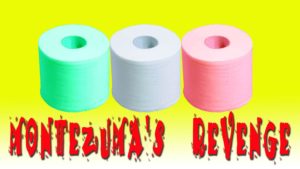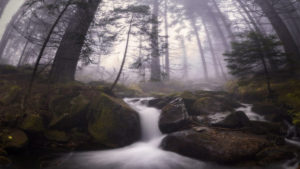Some Perspectives about Water from Some World Travelers I have Known
I grew up in Southern California in the 70’s and 80’s. We were always in a drought condition, and would be yelled at for watering the lawn and washing your car. Tap water tasted like hell, but we always knew it was safe to drink.
We also used to go camping a lot. We would go to the Mountains and the Desert. Our trailer had a sizable water tank that we could drink from. we would also bring a 5 gallon Sparklett’s bottle for drinking. All of this to know we were safe.
 I wasn’t aware of unsafe drinking water until my Mom starting using the catch-all scare tactic – Montezuma’s Revenge. The name alone was enough to have us worried. We were told that if you drank unsafe water, you would get it. There was never an explanation about what it was, but diarrhea and barfing were part of it. And that fear alone was usually enough to keep us from drinking from streams or ponds while out in the wilderness hiking.
I wasn’t aware of unsafe drinking water until my Mom starting using the catch-all scare tactic – Montezuma’s Revenge. The name alone was enough to have us worried. We were told that if you drank unsafe water, you would get it. There was never an explanation about what it was, but diarrhea and barfing were part of it. And that fear alone was usually enough to keep us from drinking from streams or ponds while out in the wilderness hiking.
When we got older, my younger sister studied up on Giardia – AKA the Thunder Shits – which became the new name for it. Either way, the rules were simple. Do not drink from streams while hiking. And when you are in Mexico DON’T DRINK THE WATER! Else Montezuma may come for a visit.
With this in mind, I have always been extra careful with the water I drink.
So when it comes to water – whether it is at home, or when you are away, what things do you think about? I have traveled a little bit – through at least 30 of the United States, Northern Mexico (OK TJ and as far as about 60 miles into Mexico), Montreal, Canada and then a month in Jolly Old England. And with the exception of Mexico, all of the water I have encountered was considered to be “safe”.
That does not mean it was drinkable taste wise. Desert water usually sucks. Many mountain springs taste wonderful, but others have such high mineral content as to taste awful. Swampy areas (The Caribbean and East Coast USA) taste swampy or like a swimming pool (that is a swimming pool filled with swamp water and Chlorine). They leave much to be desired. As far as big cities go, it is said that New York City has great tasting water. I do not remember myself, though I have been there many times.
So I have asked some of my friends on Facebook who travel a lot about their thoughts are on drinking and traveling.
 Paul Constantine – who I went to high school with. He has traveled as a tourist extensively:
Paul Constantine – who I went to high school with. He has traveled as a tourist extensively:
When you asked this question the first country that came to mind was Iceland. The country is loaded with huge waterfalls and numerous rivers. The water is clean and cold. You can drink right out of the streams. You can’t do that in most parts of the world without getting sick. They use their hot springs as bathing areas.
Most of Europe is like being in the the U.S. you have better water quality in the country side and less desirable water near the major cities. I usually drink bottled water to avoid getting sick.
 Roland and Galina Denzel – Also a high school friend and his wife who is from Bulgaria.
Roland and Galina Denzel – Also a high school friend and his wife who is from Bulgaria.I live in an area with hard water, so it’s always interesting to me how ‘slick’ showers feels when I travel. It makes me wonder about the drinking differences.
Many of the places we travel don’t have consistently safe water in the city, so they (and we) drink filtered or bottled, but it’s great when we go to the villages where they get water from wells. The water tastes pretty amazing. This city boy kind of cringes at first, but I’ve never gotten sick from the mountain springs in Bulgaria. They come bubbling straight out of the ground and taste so pure and clean.
Usually my rule of thumb is anywhere outside Canada, the US, or Europe, to drink only bottled water (plus juice, plus beer/wine). I seem to recall the tap water in Japan was ok, but I relied on bottled water in Thailand, Malaysia, Indonesia, and of course India.
It was suggested to me to immerse in the Ganges at Varanasi, the holy city, only the water there is totally septic…because it is too far downstream at that point with too much waste entering along the way…but I did immerse at Rishikesh (where the Beatles went to meet the Maharishi in ‘68) because, being in the Himalayan foothills, it is much closer to the source, and it is translucent enough that you can see fish swimming in it, meaning it is water that won’t kill fish, like in Varanasi. Got all the spiritual benefits with none of the health problems.
There is absolutely nowhere in Latin America or Africa where I would drink tap water.
NOTE: Sheldon wrote this to me from Paris as he was preparing for a trip to Africa, where he has been for the past couple weeks. This picture is of water buffalo (I think) in Uganda.
1) Kharkiv, Ukraine, 2001: Instructed not to drink the tap water, only bottled. Water from shower head either icy cold or burning hot, no in between. Sometimes no hot water for a week, sometimes no water for a day or two.
2) Lviv, Ukraine, same time period: told that because of old pipes there is only water available from the tap from 6-9 am and 6-9 pm.
3) Astana, Kazakhstan, present day: No one drinks tap water. 5-gallon water dispensers in nearly every university office. Frequent leaks and outages mean sometimes no water for a few hours to a day, and then when it comes back the water comes out brown for a while. That’s why I usually have a bottle in the bathroom and one in the kitchen filled with tap water on reserve in case I need to wash hands, brush my teeth, or heat water for a “bucket bath”.
But, final story: going into the hills of Almaty on the way to Big Almaty Lake. Our driver found a place to stop with a natural spout. It was the purest cleanest tasting water I have ever had in my life.
Hope that’s enough.
